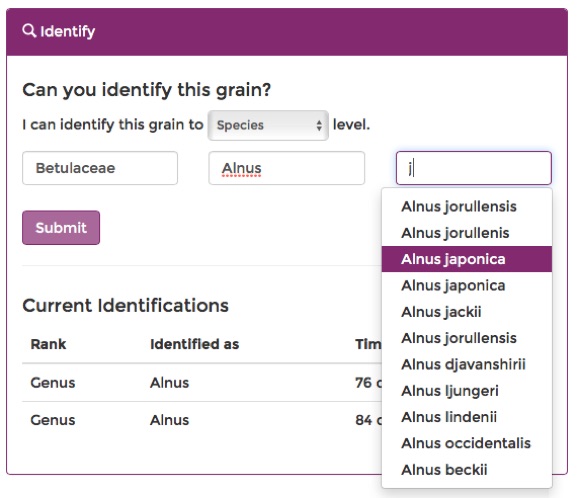Guide
Quick Start
The Global Pollen Project is an online platform that facilitates the storage and organisation of pollen images which can be accessed freely and globally. Its framework has been specifically designed to encompass: access, transparency and uniformity going forward through time.
There are two main concepts for which the Global Pollen Project can be used for: (1) the identification of unknown grains, and (2) as a morphological reference collection.
- If a user has a pollen grain that he/she can not identify then they may upload it to the Global Pollen Project for a crowd sourced identification here. The quality of the identification is mediated by our identification model. Once an unknown grain has satisfied the criteria of the identification model it is passed into the master reference collection.
- The master reference collection is comprised of images of material from known botanical sources as well as morphologically identified images. This reference collection may be used to help identify unknown grains. A user may also contribute their own collections to be used as reference material here.
We hope that this tool will promote increased research and help share expertise to encourage people to tackle palynological research in more challenging parts of the world producing higher resolution taxonomic identifications and studies. In doing so we also hope to bridge the gap between the modern and palaeo scientific spheres. We aim to progress the palynological discipline further towards a digital age, disseminating data freely and easily, tackling dark data, and providing a tool which can be used to educate in research, schools and amateur hobbyists.
Taxonomic Backbone
Taxonomic organisation has been implemented through a hierarchical system to relate submitted pollen images to their corresponding species, genera and families. The taxonomy is constrained such that the higher taxonomic ranks are required for a genus or species. New taxa are created automatically when a new user-submitted grain becomes identified, or a slide is digitised for a new taxon. To overcome taxonomic conflicts between collections, we implemented a dynamic taxonomic backbone. This is linked directly to The Plant List (2013), requiring that any new taxon generated in the Global Pollen Project must exist on The Plant List as an accepted taxon. Synonyms will not be accepted and must be inputted in accordance with current convention. This ensures that our taxonomic hierarchy is rigorous and up to date with the global authority on plant nomenclature (The Plant List, 2013).
Master Reference Collection
The reference collection is a dynamic library of all taxonomically-verified pollen images held by the pollen project, including:
- Digitised reference slides. These have been uploaded by a contributing institution. If you use these images, please include the full attribution given on the page.
- Individual grains that have become identified. The analysis is currently running, with data being computed. The report is also compiled during this process.
You can browse the collection by family, genera, and species, and navigate between taxa using the taxonomic heirarchy.

Searching the Collection
The reference collection is a dynamic library of all taxonomically-verified pollen images held by the pollen project, including:
- Digitised Reference Slides. These have been uploaded by a contributing institution. If you use these images, please include the full attribution given on the page.
- User Grains that have been Identified. The analysis is currently running, with data being computed. The report is also compiled during this process.
You can browse the collection by family, genera, and species, and navigate between taxa using the taxonomic heirarchy.

The Taxon View
The taxon view displays all reference slides for the taxon selected. This includes slides that belong to taxa that are children of the current selection, for example all species within a genera.
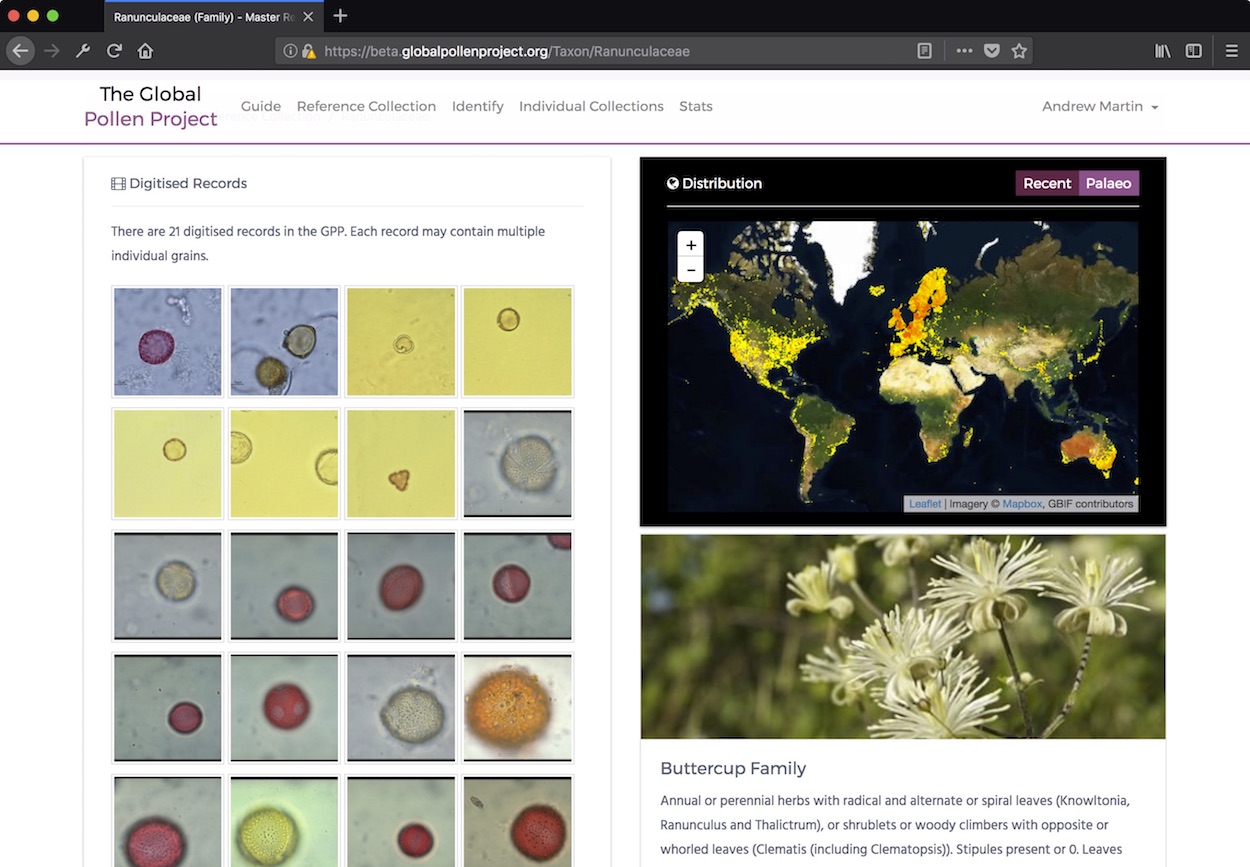
There are four information panels displayed for every taxon:
Digitised Reference Slides
Any digitised reference slides for the selected taxon, and any underlying genera / species, are presented together for visual comparison.
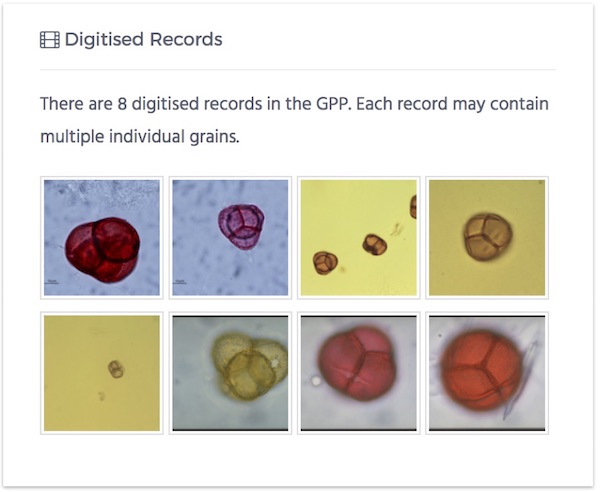
Present and Past Geographical Distributions
To help to distinguish between taxa that may or may not occur within your area of interest, we present past and present occurrences of taxa within the taxon view.
- Present-Day Occurrences. We link dynamically to the Global Biodiversity Information Facility (GBIF) to retrieve occurrences between 1990 and the present day.
- Past Occurrences. Neotoma is accessed to present past occurrences (determined from pollen and plant macrofossils) from 1,000 years before present to 50,000 years before present. Use the horizontal scrollbar to filter the data to a particular temporal extent.
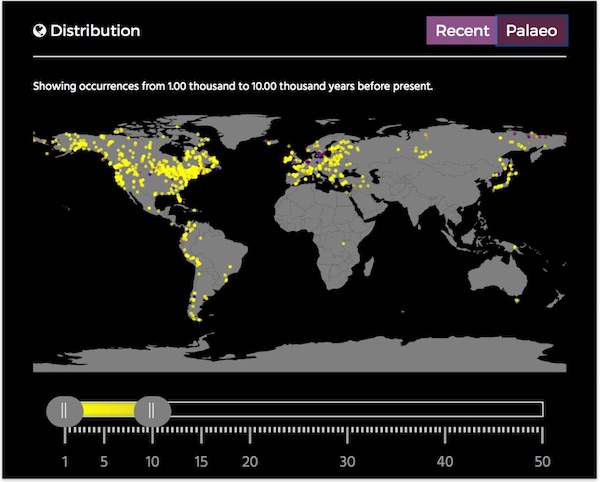
Botanical Description
We connect each taxon in the master reference collection to Encyclopedia of Life. Trusted information is presented where a connection can be successfully made, including the common English name, botanical description, and an image. Please follow the link to Encyclopedia of Life from any taxon page, where additional similar information may be available.
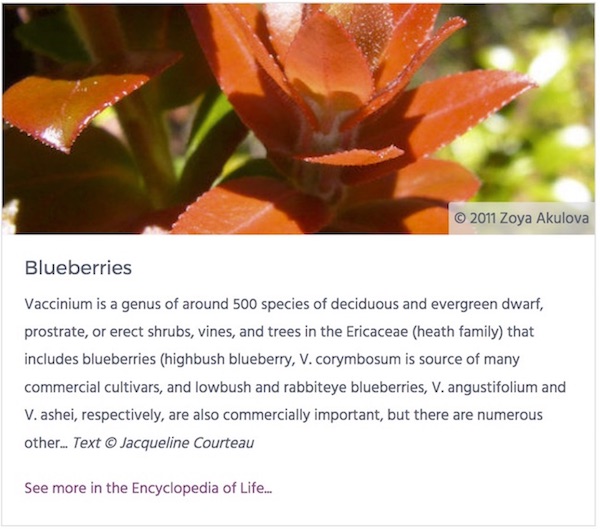
Statistics
We show the representitiveness of our current collection compared to the taxonomic backbone.
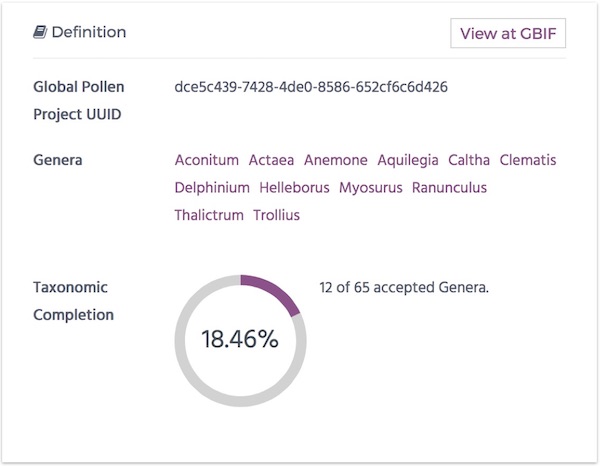
Identify Pollen Grains
Have expertise in pollen identification? Help others, and score on the leaderboard, by identifying some pollen grains.
The taxonomic backbone actively helps to fill in the family for any valid genera that you enter. Any identifications are checked against the backbone for validity.
Identify grains now.